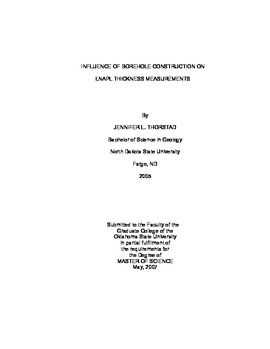| dc.contributor.author | Thorstad, Jennifer Leigh | |
| dc.date.accessioned | 2014-03-14T21:52:19Z | |
| dc.date.available | 2014-03-14T21:52:19Z | |
| dc.date.issued | 2007-05-01 | |
| dc.identifier.uri | https://hdl.handle.net/11244/8064 | |
| dc.description.abstract | Electrical resistivity images taken at sites contaminated by gasoline or light non-aqueous phase liquids (LNAPL) often image LNAPL being affected by the location of boreholes as either an attractive or repulsive feature in the subsurface. This mechanism results in an anomalously low or high estimate of the amount of LNAPL in the formation using data sampled from wells. The field data suggest that in fine grained media LNAPL may not be detected by monitoring wells. A numerical model was constructed to determine if the hydraulic conductivity contrast between a borehole and natural media has a significant enough effect to create either a convergent or divergent two-phase flow field around a borehole which would lead to inaccurate LNAPL measurements. The model results indicate that ambient gradients are not sufficient to create the observed geophysical effect, but do demonstrate that the wells may never reach equilibrium with the formation. | |
| dc.format | application/pdf | |
| dc.language | en_US | |
| dc.publisher | Oklahoma State University | |
| dc.rights | Copyright is held by the author who has granted the Oklahoma State University Library the non-exclusive right to share this material in its institutional repository. Contact Digital Library Services at lib-dls@okstate.edu or 405-744-9161 for the permission policy on the use, reproduction or distribution of this material. | |
| dc.title | Influence of Borehole Construction on Lnapl Thickness Measurements | |
| dc.type | text | |
| osu.filename | Thorstad_okstate_0664M_2265.pdf | |
| osu.college | Arts and Sciences | |
| osu.accesstype | Open Access | |
| dc.description.department | Boone Pickens School of Geology | |
| dc.type.genre | Thesis | |
